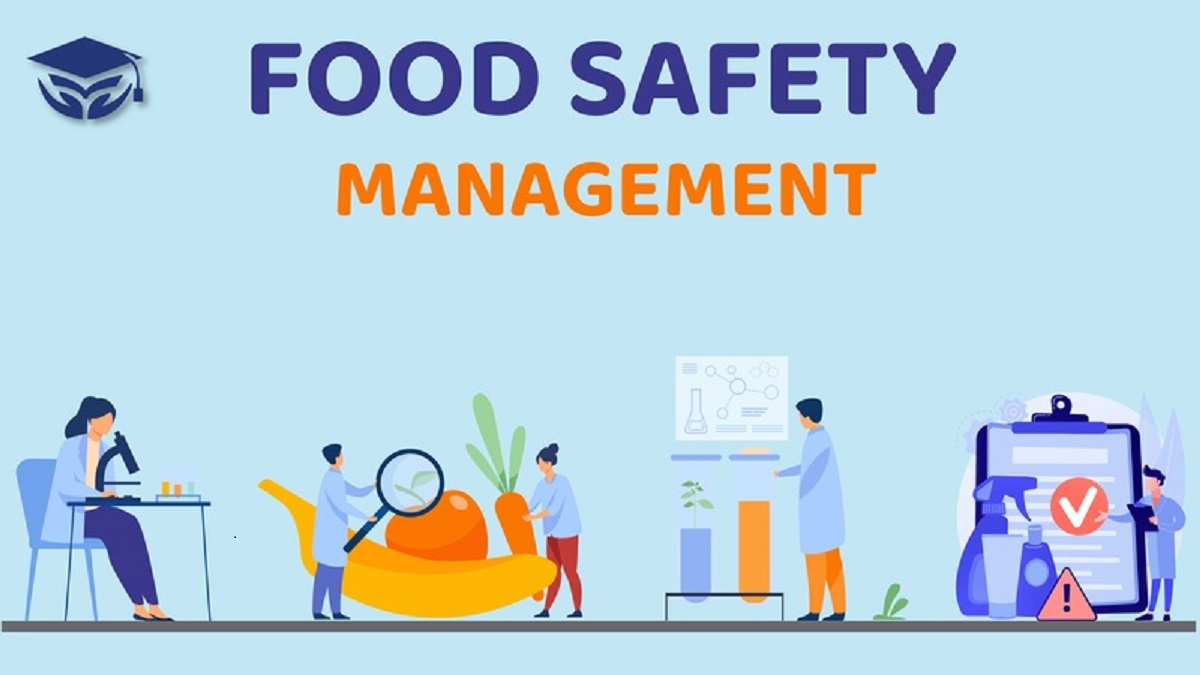All You Need To Know About Food Safety Management System
When most of us go shopping for food products or frequent our favorite restaurants, we rarely think about food safety. We are confident that the food we are eating or buying is handled correctly and can not cause any foodborne illness. However, it is not as we are thinking, and many foodborne diseases enter the food products during handling and processing. So It is not a simple process to guarantee food safety for a long period, but with a proper food safety management system (FSMS), you can control hazards and manufacture safe food products.
Businesses in the food and beverage sector need to pay close attention to product safety. Any issue brought on by the products can harm consumers’ perceptions of your company. It demonstrates how important it is for food businesses, restaurants, and cafés to implement FSMS.
In this blog, we will discuss all the things you need to know about the food safety management system so that you can understand its importance.
What is a Food Safety Management System?
A food safety management system is a program that ensures that all the food products being produced are free from hazards and safe to consume. It is applied to all stages, from preparation and processing to packaging and preservation. It also takes into account the transportation of the finished products. It means there would be a defined process for each process and activity. In addition to FSMS, you have to follow the principles of Hazard Analysis Critical Control Point (HACCP), and it is the responsibility of every organization to form procedures based on these principles. Food safety management systems also help food industries to comply with international standards such as ISO 22000.
What is the Purpose Of the Food Safety Management System?

The purpose of FSMS is to make sure that food is safe to consume and that it will not cause any foodborne illness among consumers. It also includes managing kitchen safety in restaurants and cafes. Any food incidents or safety-related issues can even lead to your business closure.
So If you want to maintain both your business reputation and consumer confidence, it is essential to have documentation of a food safety management system. Other than the food safety system help you in different ways, including:
- Fewer complaints from consumers or clients.
- Opportunity to get ISO 22000 certification.
- Minimize food product recalls or returns.
- Standardized compliance with international food laws and regulations.
Food safety management systems are considered more important in times of pandemic. Those who apply food safety systems have a certified guarantee that the food they serve is suitable to eat.
Key Elements Of Food Safety Management System:
Food safety systems look different in different production environments, most food manufacturers follow the principles of ISO 22000. Here we are describing some key elements of the food safety management system to ISO 22000:
1. Interactive Communication
Interactive communication means building trust between providers, suppliers, distributors, and consumers of food. Although a food business operator may not have access to all the stakeholders, they should at least be in contact with:
- Who they are getting their food from. It includes the stakeholder preset above them in the supply chain.
- Who they are giving their food. It includes the stakeholders below them in the supply chain.
These two stakeholders should be aware of the food safety management system, or they have to be actively involved in the creation of food safety systems. Food manufacturers should also consider the preferences, requirements, and specifications of their stakeholders when it comes to food safety.
2. System Management
System management is a process through which food business operators ensure the effectiveness of their food safety systems. Food manufacturing companies can use any method that suits them. However, using the ISO method is recommended for system management. Following are the principles of ISO management.
- Customer focus
- Engagement of people
- Process approach
- Leadership
- Evidence-based decision making
- Improvement
- Customer relationship management
3. Prerequisite Programmes
Prerequisite programs are good hygiene practices that are basic conditions to maintain hygiene during food production. ISO designs these as basic activities and conditions essential to maintaining food safety in a food manufacturing company and supply chain. According to Food and Agricultural (FAO), the following are some examples of prerequisite programs:
- Good Manufacturing Practices (GMP)
- Good Hygienic Practices (GHP)
- Good Agricultural Practices (GAP)
4. Hazard Analysis Critical Control Point (HACCP)
HACCP is a worldwide food safety management system that can suit food businesses of all types and sizes. It includes a set of principles that help food businesses in analyzing all the possible risks related to food safety and put controls to eliminate these risks.
For instance, you have developed a line of chocolate muffins based on an old family recipe and launched a company for mass production of muffins. One essential thing you need to do is create your own food safety management system it follows HACCP principles.
Here are seven principles of HACCP that you should keep in mind when creating FSMS for your food business:
- Identify the potential hazards, such as the handling of raw materials.
- For each potential hazard, determine the critical control points. It can be like checking the fresh ingredients’ expiry date.
- Establish critical limits such as the minimum and maximum refrigeration temperature for the storage of chilled products.
- Implement procedures for monitoring critical control points (CCPs). It may include a daily checklist to ensure that the dates of fresh ingredients have been checked.
- Establish corrective actions for CCPs. It helps you if something goes wrong with your critical control point. For example, disposing of food products that have been present in the temperature danger zone for more than four hours.
- The next step is verification to make sure that all the food safety and hazard control steps are working correctly.
- The last principle of hazard is documentation. You have to implement a record-keeping system. It is essential to ensure accountability and traceability.
What Are The Basic Steps Of the Food Safety Management System
If you are starting a food safety system for your food business, here are a few steps that you must take into account.
Identify need, objective, and scope.
When starting FSMS, you may wonder why my business needs a food safety system. No organization is perfect, and you may already notice some issues affecting different operations. These areas of improvement are essential to notice because they will help you structure FSMS.
Once you know what needs to be fixed, you can easily craft the FSMS to match those needs. Here are a few things that you must notice to take a good start:
- Conduct a hazard analysis to find which food safety hazards usually go unchecked.
- Find which safe food handling practices are not followed, such as cleanliness, poor thawing, heating, or storage methods.
- Frequent complaints from customers.
- If your business has experienced any serious food incidents like foodborne illness.
- Results of health and safety inspection.
After the identification of needs, that is why your food business requires a food safety system to move on to the scope. To find the scope of FSMS, you must consider:
- Which problems of your food business this food safety management system can solve, and which can it not solve?
- If the problems that FSMS can solve are on your priority list.
You should make a priority list of three to five major problems and then think of a goal to help lessen these problems’ impact. The finalized goals will become the objective of FSMS. Always keep in mind that each goal must be S-M-A-R-T: Specifics, Measurable, Achievable, Realistic, Timely.
1) Create Food Safety Policy
A food safety policy is set to describe how an FSMS will accomplish its goals. It should include a management structure that enables a food business to proceed with improved food safety practices. A viable food safety policy must include the procedures for when:
- A food incident related to your food business occurs.
- Consumer complaints through a third party, particularly when it is a legal action or formal complaint.
- When there is an issue of food fraud.
- Food has been declared unsafe by a third party or internal audit of the food business.
- A credible authority declared food unsafe, and it must be recalled.
2) Establish Hazard Control Plan
For each product being manufactured in your facility or sold by you, there should be a hazard control plan which includes the following:
- A complete description of food and food products.
- Characteristics of all the raw materials, ingredients, or product contact materials.
- Intended use and consumers, for example, if the product has any specific nutritional goal or is designed for a specific group of consumers.
- Processes involved in handling, preparation, processing, and distribution of food.
- Hazard is associated with every step of manufacturing and storage.
- The acceptable levels of hazards.
- Corrective actions to take in case a hazard exceeds its limit.
- Control measures to ensure that hazards are within acceptable limits.
Hazard control plans should be updated frequently, and all employees should be trained to follow this plan.
3) Follow Prerequisite Programmes
As we described above, examples of prerequisite programs are GAP, GMP, and GHP. in order to follow the GMP prerequisite program, you have to create standard operating procedures as a food manufacturer along with conducting regular GMP audits. For the GAP prerequisite programs, food business operators will need to assess the site history to identify contamination risks and monitor storage and handling.
On the other hand, GHP prerequisite programs need food business operators to observe the cleanliness of the premises, equipment, and workers. It includes enforcement of regular sanitation and personal hygiene. Other prerequisite programs include pest control purchasing and food waste management.
4) Measure the Effectiveness of the Food Safety Management System
Though food manufacturers should be proactive in maintaining the food safety management system, it does not mean it is unchangeable. Like any other management system, you can review and improve FSMS regularly. A good way to analyze your FSMS is to look at the objectives and improve them if needed.
Benefits Of Having a Digital Food Safety Management System
Due to the scale of critical control points and the number of records, a digital solution for a food safety management system has become essential. A digital food safety system gives employees and management easy access to documentation. These documentations include checklists of critical limits and control points.
In addition, a digital FSMS also acts as a centralized location to implement corrective action, and you can get real-time reports. You can also easily track the products throughout the food supply chain. The digital food safety system benefits companies operating globally, as it helps in risk control throughout the food supply chain.
How To Improve the Food Safety Management System?
Now you know well that FSMS is essential to manufacture safe food products. Food business operators should continuously analyze and improve their food safety systems. A simple and easy way to improve FSMS is to use successful HACCP templates. You can also consult with food safety experts to establish efficient food safety systems. Furthermore, you can choose a digital solution to manage your food safety system in a better way.
Conclusion
Food business operators must manufacture products that are safe to consume. It will not only be beneficial for the health of consumers but also for the reputation of the business. A food safety management system is a set of procedures and practices that helps in controlling food safety hazards and taking measures to mitigate risks. You should take into account the potential hazards to establish the right food safety system for your facility.
Read More: TOP 10 CREATIVE WAYS TO REDUCE FOOD WASTE



